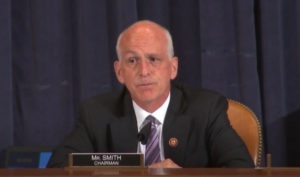The House Armed Services Committee (HASC) early Thursday morning advanced its version of the next National Defense Authorization Act (NDAA) with a bipartisan vote, moving forward the bill after agreeing to boost defense spending by nearly $25 billion.
Following more than 16 hours of debate, the panel adopted several additional measures aimed at providing greater oversight into Afghanistan-related issues post-withdrawal to include information on the Pentagon’s “over-the-horizon” capabilities and a detailed list of equipment left behind in the country.

“This year the defense bill focuses on transforming DoD to better deter our adversaries while taking advantage of new, innovative technologies and implementing a more cost-effective approach to develop and acquire crucial platforms. The future of our defense depends on our committee’s tough policy discussions about what DoD needs, how to fill these needs, and the necessary tradeoffs to ensure the United States maintains a competitive edge over its adversaries,” Rep. Adam Smith (D-Wash.), the HASC chair, wrote in the statement following the bill’s passage.
HASC ultimately voted 57-2 to advance its NDAA, with Reps. Ro Khanna (D-Calif.) and Sara Jacobs (D-Calif.) as the two ‘no’ votes. Khanna noted earlier in the markup he would oppose the bill after the committee approved adding an additional $23.9 billion to the topline.
Rep. Mike Rogers (R-Ala.), the HASC ranking member, introduced the topline boost as an amendment, with the additional spending covering the full range of DoD’s unfunded priorities submitted to Congress as well as 200 member priorities not included in the underlying bill. The panel voted 42-17 to adopt the measure (Defense Daily, Sept. 1).
A total of 14 Democrats joined all of the panel’s Republicans in supporting the topline increase.
The Senate Armed Services Committee in July voted to approve a $25 billion boost to its own version of the NDAA, which also received bipartisan support among the committee (Defense Daily, July 22)
Following the topline discussion, much of the debate focused on a series of amendments related to the Pentagon’s use of critical race theory teachings in educational settings, drawing the ire of some panel members who urged the committee to focus on measures directly related to national security.
“Do you think the Chinese are debating critical race theory? No.,” Rep. Elaine Luria (D-Va.) said, noting HASC spent over an hour on the topic as opposed to debating the topline increase for just under a half hour. “These amendments are a waste of time and do not do a damn thing to improve our national security.”
HASC then shifted to provisions related to oversight following the Pentagon’s withdrawal from Afghanistan, as well as approving an amendment from Rep. Liz Cheney (R-Wyo.) to establish a bipartisan “Commission on Afghanistan” that would provide a report by next August on findings from the last 20 years and recommendations for the future.
“This is exactly what we need to do. This has been 20 years…and there has been a lot of hearings, a lot of decisions, a lot that went into this and I think there is a lot to learn from that experience,” Smith said of the commission.
Rep. Jason Crow (D-Colo.) introduced amendment requiring the defense secretary and director of national intelligence to submit a report once a year through 2026 on the Pentagon’s “over-the-horizon” capabilities dedicated for counterterrorism operations post-Afghanistan, as well as an assessment of terrorist threats and plans to adjust the force or capabilities relative to changes in the threat level.
“We think this is a pragmatic first step in engaging the Congress in this oversight and engaging with the department and the administration to ensure that our immediate counterterrorism threats and force protection threats are addressed adequately,” Crow said.
Rep. Don Bacon (R-Neb.) introduced a separate amendment that requires the defense secretary to provide a report within 180 days and then a briefing to HASC within 200 days on equipment left behind in Afghanistan and the assessed value of that equipment.
Marine Gen. Frank McKenzie, the head of Central Command, told reporters on Monday, the final day of operations in Afghanistan, that U.S. forces “de-militarized” its C-RAMs, around 70 Mine-Resistant Ambush Protected vehicles, 27 Humvees and 73 aircraft before withdrawal operations concluded to ensure the equipment could never be used again (Defense Daily, Aug. 30).
Both Bacon and Crow’s amendments to the bill were adopted by voice vote.
The panel also adopted another measure from Cheney that would bar the reduction of deployed Intercontinental Ballistic Missiles below 400 weapons, with members viewing the measure as non-controversial and approving the amendment by voice vote.
“A 400-missile arsenal provides the United States with the dynamic capability to shift or increase land-based warhead placement and the cost of maintaining the current fleet does not diminish linearly when the fleet is reduced. The number 400 is one that is necessary to deter or retaliate if deterrence fails,” Cheney said.
Both HASC and SASC’s respective versions of the FY ‘22 NDAA must still head for a floor vote before a conference committee is established to settle difference between the two bills.